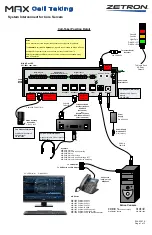
Chapter 8 – Operation
44
TB42/TB50 – 0075251EE
When the machine is in the stowed position, with the
booms centered between the rear wheels, the direction
of drive and steer control movement corresponds with the
direction of chassis movement.
When the turntable is rotated from the stowed position,
with the booms to either side of or in front of the chassis,
the direction of control movement does not correspond
with the direction of chassis movement.
To avoid confusion, always drive to the work area or move
between work areas with the turntable and booms in the
stowed position. After arriving at the work area, the booms
may be positioned to the side or the front of the chassis
for final positioning. Always look in the direction of move-
ment as indicated by the directional arrows on the chas-
sis.
Use the following procedure to operate the drive and steer
functions.
1. Determine the desired drive range for the specific driv-
ing conditions.
• Use high range when traveling across firm, flat,
level surfaces. High range can only be activated
when the booms are stowed. High range is for high
speed, low torque operation.
• Use low range for driving on loading ramps or other
steep grades and when safety considerations de-
mand slow deliberate machine movement. Low
range is for low speed, high torque operation.
2. Place the drive/boom selector switch in the drive po-
sition.
3. Step down on the platform foot switch.
4. Push the drive joystick forward to move the chassis
forward, the direction of the blue arrow. Pull the joy-
stick backward to move the chassis backward, the
direction of the yellow arrow. The drive speed is pro-
portional to the joystick position.
5. To stop drive motion, return the joystick to neutral.
6. Push the drive joystick to the right to steer to the
right, the direction of the yellow arrow. Push the joy-
stick to the left to steer to the left, the direction of the
blue arrow.
Note
The steering wheels are not self-centering. Set the steer-
ing wheels straight ahead after completing a turn.
7. After driving to the desired location, release the foot
switch, or push the emergency stop button to apply
the parking brakes.
Drive Speeds
The drive speed is proportional to the joystick position.
The farther the joystick is moved, the faster the travel
speed.
Always slow down and shift the drive system to low range
before traveling over rough terrain or any sloped surface.
Drive speed ranges are interlocked through a limit switch
that senses the main boom position. When the boom is
elevated, only the slowest drive speed will work regard-
less of the drive range switch position.
A
Warning
The potential for an accident increases when safety
devices do not function properly. Death or serious
injury can result from such accidents. Do not alter,
disable, or override any safety device.
Do not use the aerial platform if it drives faster than 1.6
km/h (1.0 mile per hour) [13.4 m (44 feet) in 30 seconds]
when the booms are elevated from the stowed position.
Motion Warning Alarm
The motion warning alarm sounds loud intermittent beeps
when the drive joystick is in the forward or reverse position.
Platform Overload Sensing System
All functions are stopped from the upper and lower con-
trols, when the platform overload limit is exceeded. The
horn will sound intermittently and the red overload light
(refer to Figure 8.5) will blink until the excess load is
removed from the platform. At that time, the machine func-
tions are again operational.
Note
If the platform overload sensing system is tripped while
operating the machine, the emergency power system may
still be used for emergency machine operation from ei-
ther the lower or upper controls.
Figure 8.5 – Upper Control Panel
If the platform becomes significantly overloaded, or if an
upward force on the platform exceeds approximately
445 N (100 lb), the system will enter into error mode,
Platform
Overload Light
Summary of Contents for TB42
Page 14: ...Chapter 2 Specifications 10 TB42 TB50 0075251EE ...
Page 30: ...Chapter 6 Controls 26 TB42 TB50 0075251EE ...
Page 44: ...Chapter 7 Prestart Inspection 40 TB42 TB50 0075251EE ...
Page 58: ...Chapter 10 Emergency Operation 54 TB42 TB50 0075251EE ...
Page 66: ...Appendix A Glossary TB42 TB50 0075251EE ...
Page 68: ......
















































